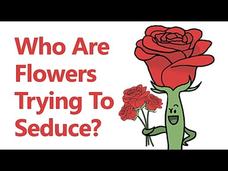Amoeba Sisters
Plant Reproduction in Angiosperms
A colony of bees has moved into someone's home and the owners know how important bees are for pollination. Should they keep the bees? An informative video also includes a guide to plant reproduction including the male and female parts,...
Crash Course
The Plants and the Bees: Plant Reproduction
This video explains the difference between gametophytes and sporophytes and uses this this information to teach the reproduction process of various vascular plants. Viewers see how ferns, gymnosperms, and angiosperms reproduce.
Curated OER
Plant Reproduction: Asexual Reproduction
Asexual reproduction in plants occurs from bulbs, perennating organs, or even gardening techniques like cuttings. Commercial growers rely on the ability of some plants to reproduce asexually and grow roots rather than starting from...
Amoeba Sisters
Asexual and Sexual Reproduction
Why do some organisms reproduce sexually, others reproduce asexually, and some both? Biology scholars examine the pros and cons of sexual and asexual reproduction through a short, informative video. The resource offers great examples of...
Curated OER
Life Cycle of a Flowering Plant
The development of the male and female gametes in a plant is illustrated, explaining plant fertilization, pollination, and reproduction. Overall, get a complete picture of the life cycle of a flowering plant with some wonderful details...
Odell Education
Plant and Animal Cells
Incorporate multiple facets of the cell into your next high school lab! Through an introduction to cell organelles, class members observe each cell type and draw visuals to further demonstrate understanding of cellular processes in both...
Curated OER
Photosynthesis and Plant Reproduction
Students explain the process of photosynthesis. In this biology activity, students label the different reproductive parts of the flowers. They watch a short video then identify the leaf parts on the board.
PBS
Seasonal Science: Pine Pollen
More than 125 species of pine trees exist, and each species can live over 100 years, with some living over 1,000 years—that's a lot of pine pollen! The Seasonal Science series explains why pine trees produce pollen. The video details the...
Curated OER
Flower Dissection
Beginning biologists pull a flower apart and familiarize themselves with the different reproductive structures. Why have them learn only from just a book or diagram when they can examine real samples? There is no link to the referenced...
Curated OER
Cells: A First-Hand View
In the first of two activities, your charges prepare wet mount slides of cork and bean sprout cells in imitation of Robert Hooke's historical investigation. An excerpt from his notes is included. Then, investigators compare animal cells...
Scholastic
Study Jams! Flowers
RJ hangs out in Zoe's garden as she explains pollination, flower anatomy, and fertilization. This cartoon-styled feature is sure to stay in your botanists' minds! Follow it with the dissection of large flowers, such as the lily.
Virginia Department of Education
Animal Phyla and Plant Divisions
Searched hours for an activity that allows individuals the ability to use multiple resources to learn about both plant and animal kingdoms? This discussion and activity provide pupils with the ability to visualize each organism before...
PBS
How Sex Became a Thing
Birds, bees, flowers, trees ... and Funisia dorothea? Biology scholars journey back in time to discover more about the history of sexual reproduction. The video, one of many in a biology playlist, covers our earliest eukaryotic ancestor,...
MinuteEarth
Who Are Flowers Trying to Seduce?
Learn the tricks plants use to attract insects and animals in their quest for pollination. A thorough video lesson describes plant adaptations that meet their reproductive needs. From bees to rodents to bats, the narrator describes how...
Curated OER
Variations in Growth and Reproduction of Recently Transplanted Prairie Forbes and Grasses
students recognize and name prairie plants without the use of a key. they determine that prairie plants have different life cycles that affect their rate of growth and reproduction
Crash Course
The Sex Lives of Nonvascular Plants: Alternation of Generations
Plants evolved more than 400 million years ago into two types — vascular and nonvascular. Here's a video that explains the difference between vascular and nonvascular plants and then focuses on the over 24,000 types of nonvascular...
Curated OER
Plant Reproduction
Students identify the different parts and function of a flower's reproductive system. In this biology instructional activity, students explain how pollination works. They watch a video and practice labeling parts of both flower and leaf.
Curated OER
Regents High School Examination: Living Environment 2003
The living environment, from the interior of a cell to the complex relationships among populations, are queried in this final examination. Learners look at air pollution maps, diagrams of cells, population graphs, and drawing of cells....
Curated OER
Pollination, Plants and Insects
The pollination of milkweed involves a high risk for the bees and butterflies involved. Though the nectar is sweet and delicious, the pollen is very sticky. If a bee is not strong enough to pull the pollen free, he will be stuck and die....
Curated OER
Regents High School Examination: Living Environment 2010
This exam touches upon every topic within the typical first year biology course.. A broad variety of question styles give high schoolers every opportunity to show what they know. Why start from scratch when a comprehensive final exam is...
Curated OER
Regents High School Exam: Living Environment 2008
Tne New York Regents High School Examinations are comprehensive and include various styles of questions, includingmultiple choice and the analysis of graphs. This particular version, the 2008 Living Environment exam surveys a variety of...
Curated OER
Regents High School Examination: Living Environment 2005
The 2005 version of the Regents High School Examination in the area of ecology is as comprehensive as previous years' exams. It consists of 40 multiple choice questions on everything from the structure of DNA to the interactions within...
TED-Ed
The Sexual Deception of Orchids
A plant engaged in sexual deception? Strange but true. Believe it or not, orchids have developed a range of sexual adaptations that permit them to attract pollinators. The narrator of a short video describes a variety of strategies used...
Curated OER
Aliens Among Us
Students identify plants growing in the school yard and choose one for further investigation. They investigate the plant's biotic potential and environmental resistance. They predict what would happen should they introduce an exotic...
Other popular searches
- Flowering Plant Reproduction
- Seedless Plant Reproduction
- Asexual Plant Reproduction
- Plant Reproduction Lab
- Plant Reproduction by Seeds
- Plant Reproduction Video
- Types of Plant Reproduction
- Plant Reproduction Parts
- Plant Reproduction Puzzles
- Plant Reproduction Do Now
- Sexual Plant Reproduction
- Plant Reproduction by Spores

























